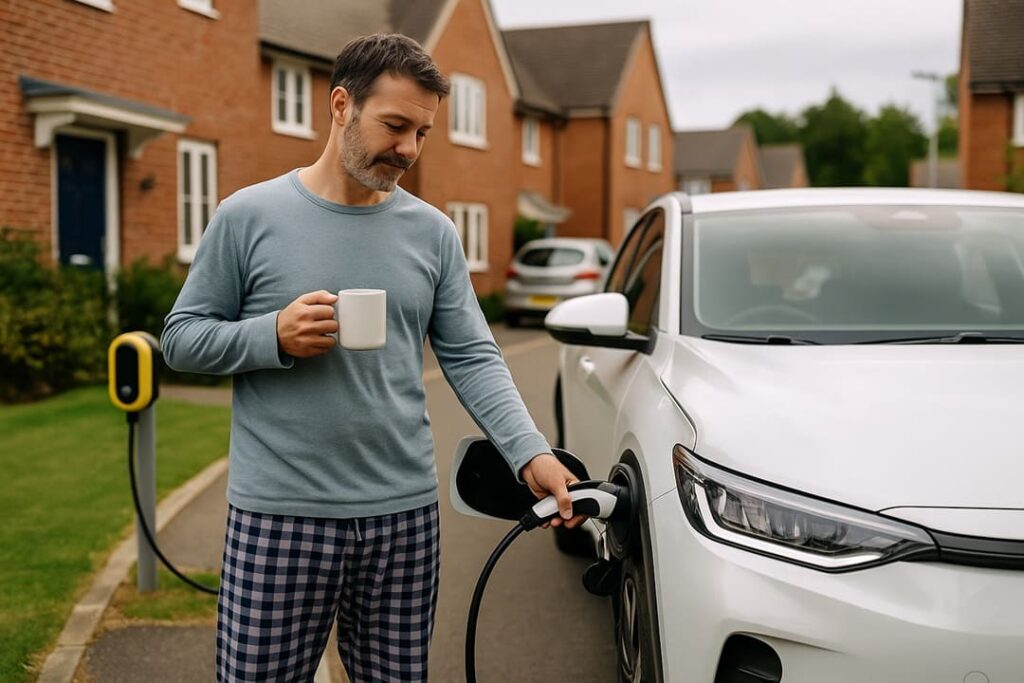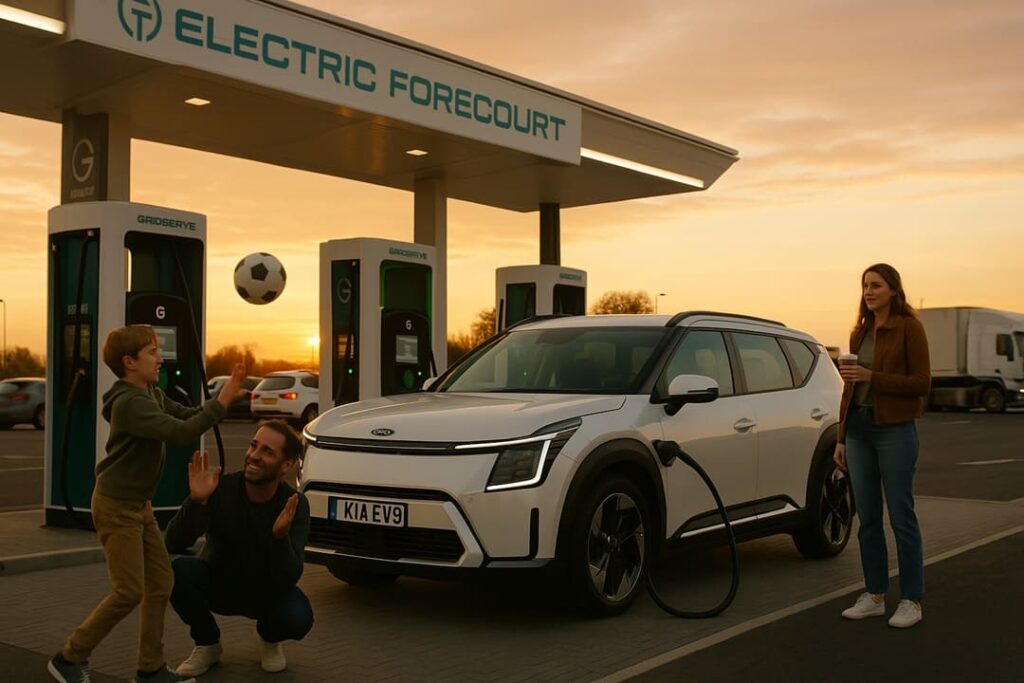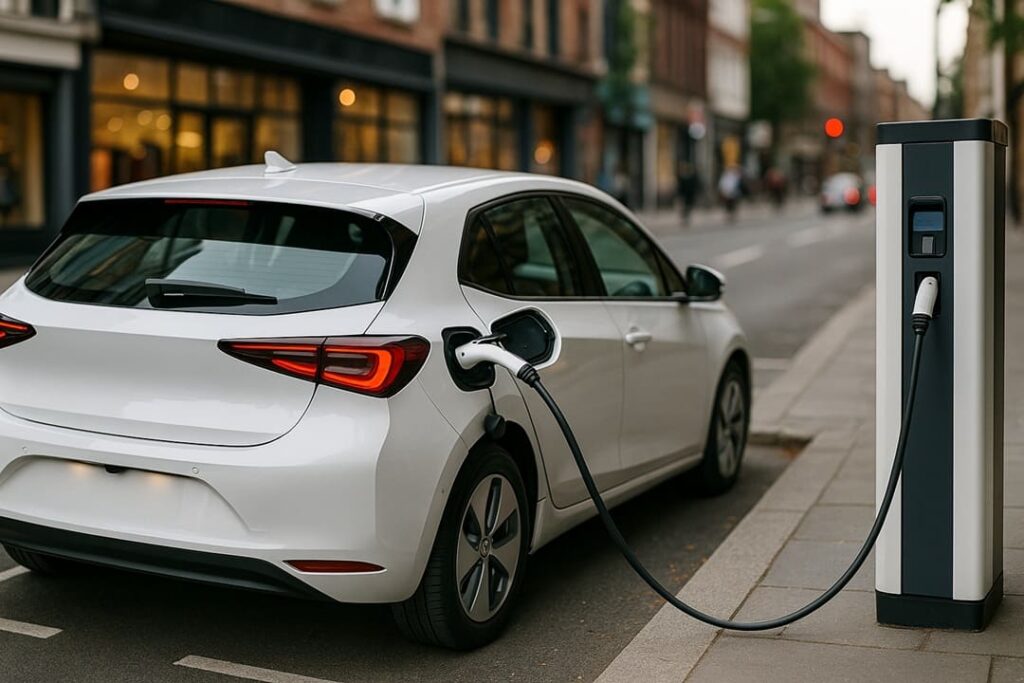The Silent Revolution Gathers Pace
You can feel it in the streets — not so much hear it. Petrol engines no longer dominate the soundtrack of our cities. In their place? The near-silent glide of electric cars that, just a few years ago, still felt like science fiction. Now, in 2025, the shift has moved from headlines to the high street, and EVs have gone from fringe to familiar.
What’s striking isn’t just how many electric vehicles are on the road — it’s how normal they’ve become. From family cars in Birmingham suburbs to smart little runarounds in central Manchester, they’re not just a glimpse of the future anymore. They are the now.
More Models, More Choice
One of the biggest shifts this year is variety. In 2025, it’s not just about Tesla anymore. Nearly every major carmaker — from VW to Hyundai, from Peugeot to BMW — is deep into its second or third generation of EVs. And they’re good. Stylish, well-built, with real-world ranges that make “range anxiety” feel a bit 2020.
In the UK, new favourites are emerging. The MG4 is winning over drivers with its mix of value and practicality. Kia’s EV9 is grabbing attention as a fully electric family SUV that doesn’t look like it’s trying too hard to be futuristic. And smaller city cars — like the Fiat 500e — are proving that electric doesn’t have to mean expensive.
Battery Tech Gets Smarter

If you thought battery innovation would slow down, think again. In 2025, we’re seeing batteries that charge faster, last longer, and perform better in cold weather — a key issue for UK winters. Some EVs now boast 300+ miles of range and can top up 80% in just 15–20 minutes at high-speed chargers.
Solid-state batteries are still not mainstream, but we’re getting close. A few prototypes from Japanese and European brands suggest they’re no longer just a lab experiment. If commercial versions arrive within a year or two, the EV game will shift again.
Used EV Market Comes of Age
This year marks a turning point for the second-hand electric car market. Early adopters are trading in their old Leafs, Zoes and i3s for newer models, which means buyers on tighter budgets are finally seeing affordable used options.
And it’s not just about cost. There’s a growing number of mechanics and garages who now know how to service EVs. Battery health reports are becoming more common. The mystique is fading — and that’s a good thing. It means electric is truly going mainstream.
Charging Gets Easier (Well, Mostly)

Let’s be honest: charging infrastructure is still a mixed bag. But it’s getting better — fast. In 2025, we’ve hit a milestone in the UK with over 65,000 public charge points, and some retail chains are installing chargers in nearly every car park.
Even rural areas are getting attention, with funding schemes pushing fast chargers into less-served regions. And on the motorways? Gridserve’s Electric Hubs are popping up with cafés, lounges and ultra-fast chargers that make long trips feel a little less like planning a moon landing.
Still, it’s not perfect. Some areas remain frustratingly under-covered. Broken chargers are still a thing. And yes — we’re still waiting for all networks to agree on one simple payment system. But overall? Miles better than just two years ago.
EVs Go Beyond the Car
Electric cars might be leading the charge, but in 2025 the idea of electric transport has expanded well beyond four wheels. Electric vans are booming, especially for last-mile deliveries in cities. Electric scooters and bikes are now a normal part of commuting, with more towns offering dedicated infrastructure.
And even public transport is catching up. Cities like Nottingham and Coventry are investing in electric buses, while some councils are piloting electric taxis with government support.
The Road Ahead Looks… Quiet
In 2025, it’s not just the number of EVs that’s growing — it’s our comfort with them. The novelty is gone, but in its place is something better: trust, familiarity, and real-world experience.
Drivers know what to expect. Charging is less intimidating. The choice is better. And perhaps most importantly, the feeling of driving something clean, quick, and future-proof has finally landed with the wider public.
The electric revolution is no longer knocking at the door. It’s already inside — and it’s not leaving.
EV Popularity by Region (2025)
| Brand | UK Popularity | USA Popularity | Europe Popularity |
|---|---|---|---|
| Tesla | Still strong, especially the Model 3 and Y. Common in cities and suburbs. | Dominates the EV market. Model Y is the top-selling car overall. | Widespread but faces stiff competition from local brands. |
| Volkswagen | ID.3 and ID.4 are increasingly visible, popular among families. | Moderate uptake. Competes with domestic brands. | Very popular in Germany, Austria, Scandinavia. |
| Hyundai | Ioniq 5 is a favourite for design and reliability. | Gaining traction quickly. Ioniq 6 is growing. | High adoption in France, Spain, Italy. |
| Kia | EV6 and EV9 are hits. Practical, stylish, affordable. | Fast-growing brand. Seen as a value alternative. | Widely respected across Europe for quality-to-price ratio. |
| MG | Rapidly rising in UK due to low prices and range. | Minimal presence. | Gaining foothold in Eastern Europe and Southern Europe. |
| Renault | Seen in nearly every UK car club. Zoe remains iconic. | Rare outside niche rentals. | Hugely popular in France and Benelux countries. |
| BMW | i4 and iX1 are favoured by urban professionals. | i7 and i4 seen as premium options. | Strong presence, especially in Germany and Austria. |
| Ford | Still lagging behind in the UK EV push. | Mustang Mach-E gaining popularity. | Slowly gaining trust in Western Europe. |
| Peugeot | e-208 and e-2008 used in city rentals. | Minimal traction. | Very common in France and Belgium. |
| Polestar | Cult following. Stylish and niche. | Popular among tech-forward drivers. | High appeal in Nordic countries. |
Car Brands Rethink Identity in the EV Era
One unexpected twist in the EV story this year? It’s not just the cars changing — it’s the image of the brands themselves. Take Volvo, for instance. Once known primarily for safe, boxy estates, the company has gone all-in on sleek, Scandinavian-styled electric SUVs. Then there’s Ford, which is leaning hard into the Mustang Mach-E as a symbol of its electric ambition — not exactly what you’d expect from a company famous for the Fiesta.
Even luxury brands are pivoting. Jaguar, for example, has announced it’s going all-electric by 2025. That’s not a gimmick — it’s a full transformation. And drivers are responding. It turns out, going green doesn’t mean giving up comfort, design, or performance. Quite the opposite. The best EVs of 2025 are fast, comfortable, and quietly confident — and the brands behind them are reinventing what they stand for.
Government Pressure and Policy Push

It wouldn’t be 2025 without some politics in the mix. The UK government’s pledge to end the sale of new petrol and diesel cars by 2035 is no longer just distant policy — it’s becoming real. Manufacturers are shifting, councils are planning, and businesses are rethinking their fleets.
In some cities, we’re already seeing signs of what’s to come. Low Emission Zones are expanding, and grants for EV buyers — while scaled back — are still helping many drivers make the leap. There’s also serious talk about “right to charge” policies in flats and terraces, making it easier for people without driveways to join the electric movement.
Of course, not everything moves smoothly. Planning delays, local resistance, and infrastructure bottlenecks remain. But the direction is clear: public policy is pointing toward electric, and it’s gathering speed.
The Culture Shift You Didn’t See Coming
Beyond all the numbers and policies, something else is changing — our attitude. A few years ago, driving an EV sparked conversations. People asked questions at the charging point. Strangers peeked into Teslas. There was novelty. But now, the conversation has cooled — in a good way.
Electric is just… normal.
We’re seeing it with younger drivers who’ve never owned a petrol car. With families who don’t think twice about driving to Cornwall in an EV. With car clubs and carsharing schemes where users pick electric without blinking. The “green badge of honour” has faded, but in its place is something more powerful: everyday adoption.
The quiet hum of an electric motor isn’t just a sound anymore. It’s a symbol that something has truly changed — not just the vehicles, but us.
